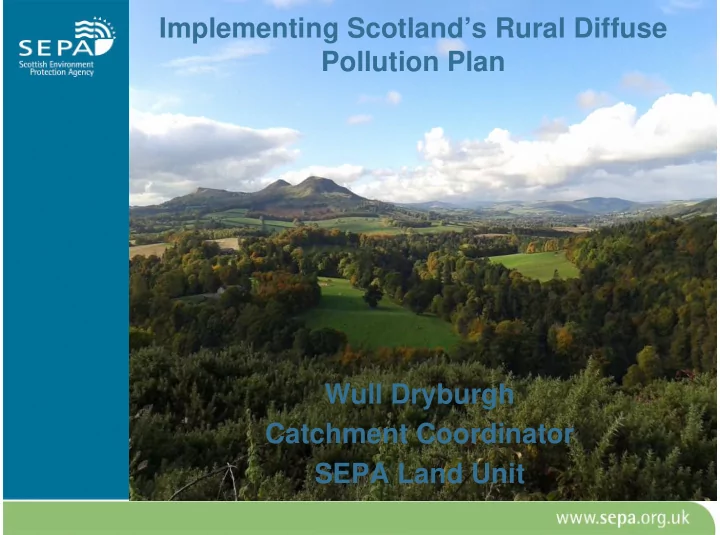

Implementing Scotland’s Rural Diffuse Pollution Plan Wull Dryburgh Catchment Coordinator SEPA Land Unit
Outline of presentation • Diffuse Pollution-why is it an issue • Mitigation methods • Borders Priority Catchment update
Diffuse pollution in Scotland Scotland’s water quality is generally good! Rural Diffuse pollution now the largest pollution pressure Individually minor, but collectively significant Sources include sediment, nutrients, bacteria & pesticides Transported from land to burns and rivers Heavily influenced by rainfall
Storage & Agrochemicals application of Cultivation slurry/FYM too SOURCE close/soil Cattle waterings erosion Roads, tracks and slopes Field/road drains PATHWAY Overland Direct access runoff Surface waters (ditches, burns, Groundwater RECEPTOR wetlands etc)
Why is diffuse pollution a problem? • Soil/sediment -> increased turbidity & habitat smothering • Nutrients (N and P) -> eutrophication of surface waters (algal blooms) and disruption to aquatic species. Drinking water also affected • Bacteria -> impact on human (and animal) health (bathing & shellfish waters) • Pesticides -> severe impact on aquatic organisms. Drinking water also affected => Overall reduction in water quality
Why is diffuse pollution a problem for farmers? • Loss of soil- its always the good stuff you lose! • Loss of applied nutrients –waste! • Livestock poaching destabilises banks, leading to soil loss and erosion. • Transmission of livestock diseases- Johne’s • Soil compaction-reduces yields, increases erosion risk, more run-off-more flooding. • Fills ditches/watercourses requiring maintenance-stop it going in in the first place! • Cross compliance-most GBR breaches are also cross compliance breaches.
River Tweed 27 th December 2015
The Diffuse Pollution GBRs cover…. • Storage and application of fertiliser (GBR18) • Keeping of livestock (GBR19) • Cultivation and harvesting of crops (GBR20) • Run-off from agricultural or forestry activities (GBR 21) • Construction and maintenance of water bound roads and tracks (GBR 22) • The handling and use of pesticides (GBR 23) • Operating sheep dipping facilities (GBR 24) The DP GBR’s apply to all ditches, burns, rivers & lochs
Sources
Pathways
Receptors
Potential solutions
Potential solutions …it’s not always about fencing • Relocating livestock feeders & salt licks • Providing shade/shelter away from burns • Maintaining field drains, troughs etc • Preventing compaction from livestock • Stock management
Cultivation Mitigation
Eye Water and Pease Bay Priority Catchment
Eyemouth Bathing Water Eye Water North Burn
Tweed/ Whiteadder update • Tweed-over 400 farms visited. Around 150 farms non-compliant with GBR’s-78% of these livestock issues (i.e. poaching or feeders too close to watercourse). • Whiteadder-137 farms visited. 54 farms non- compliant with GBR’s-80% of these livestock issues. • When compared to 1 st cycle PC’s, such as Tay and South Esk, Tay 54% livestock issues and 40% cultivation issues, South Esk 30% livestock issues 65% cultivation issues • Change mostly due to 2 metre cultivation rule becoming cross compliance and EFA (greening).
On the positive side.. • Most of the arable practice in the Tweed has been superb! • Most large arable units all using GPS for soil mapping, yield mapping, liming, variable rate spreading of fertiliser-only putting on what is needed. • Win-win – increased profitability, better for the environment.
How we plan priority catchments • SEPA has a data sharing protocol with Scottish Government- we have access to all SIACS data for farms within priority catchments • We generate databases of farms within catchments, down to sub-catchment (waterbody) level • We try to have awareness raising meetings with land managers in PC’s before we start farm visits. We always try to “multi badge” events with NFUS, SRUC. These can be evening meetings or on- farm events • We then plan farm visits.
The farm visit • We send out appointment letters with date and time of visit • We meet farmer at start of visit to get information on their farm, i.e. cropping details, stock numbers and types. • We then carry out a steading assessment, looking at silage/slurry storage, livestock housing, fuel storage, pesticide fill/mix areas etc • We then walk the water margins on the farm, recorded on rugged tablet PC. • We always try to feedback verbally at the end of the visit to discuss issues found and agree suitable mitigation if necessary
At the end of the visit • All findings discussed with farmer • Agree suitable mitigation and timescales • 12 month revisit where non- compliances identified If NO action / remedial work • has been initiated then enforcement action will be taken (If GAEC breaches recorded this may be referred to SGRPID) • SRDP funding should be available to mitigate issues identified on visit. (Last chance!)
Hot off the Press! • England and Wales now introducing “Farming Rules for Water” which will come into effect on 2 April 2018 • Environment Agency and NRW will have similar powers to SEPA in terms of rural diffuse pollution control.
Other sources of information
“Wull’s Law” Soil, nutrients and pesticides going down a river aren’t doing anyone any good…. £
Recommend
More recommend